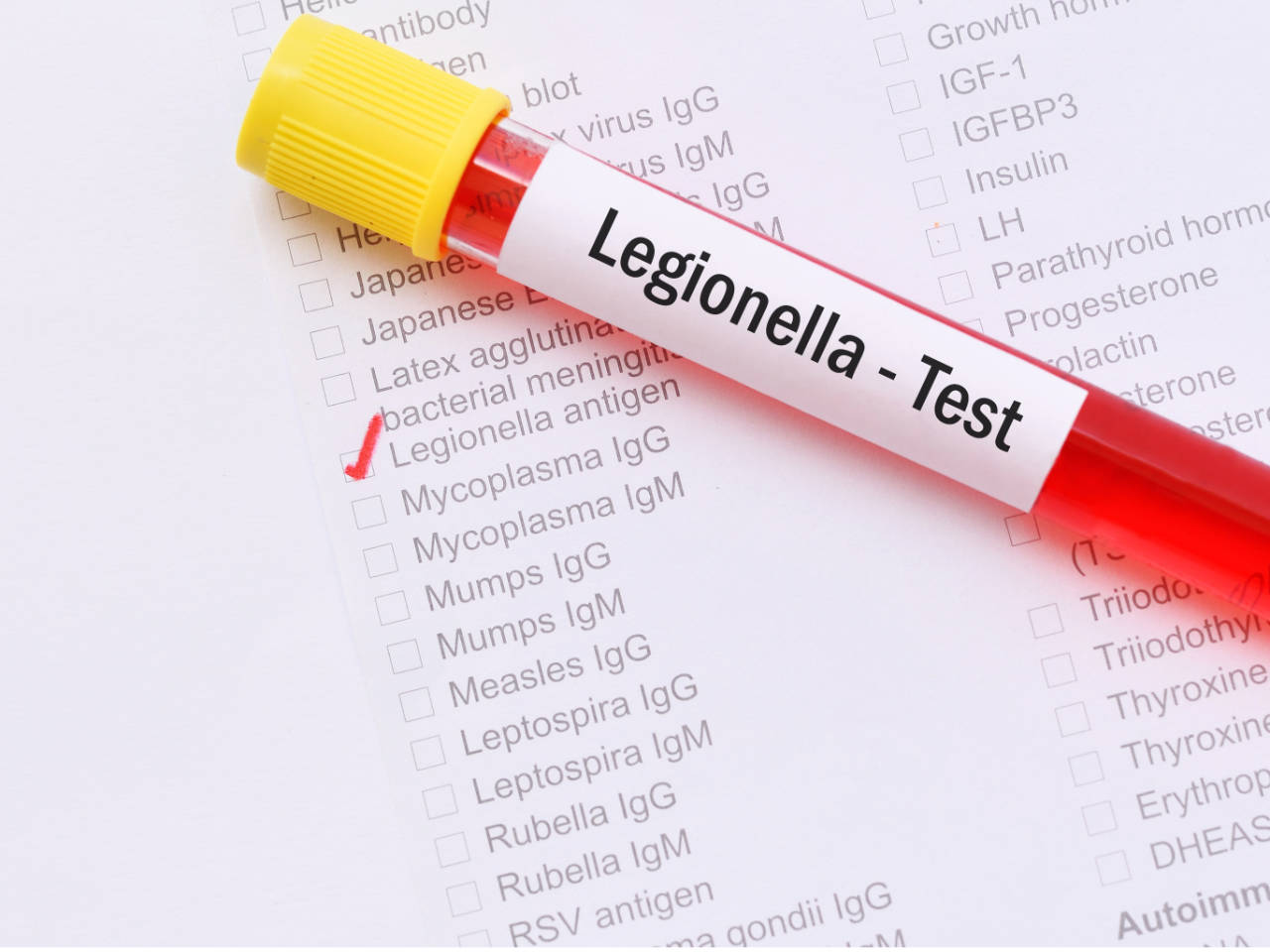
A legionella risk assessment is a comprehensive evaluation to identify, assess, and manage the risk of legionella bacteria in water systems. This guide explains the importance of legionella risk assessments, how they are conducted, and the responsibilities of employers, landlords, and others in charge of premises.
Water systems in offices, factories and other premises could potentially be a source of legionellosis, the collective term for illnesses caused by legionella bacteria (Legionella pneumophila). The illnesses include Pontiac fever and Lochgoilhead fever but the most serious is Legionnaires’ disease, a pneumonia-like illness which can be fatal.
Please read our guide, What is legionella, and how dangerous is it?
All premises where water is stored or distributed are at risk of exposure to legionella, so employers or those in charge of premises such as landlords are required to carry out a risk assessment and put adequate controls in place.

What is a legionella risk assessment, and why is it necessary?
Legionella risk assessments are required by law to identify potential hazards, evaluate risks, and implement appropriate control measures. Key reasons for carrying out a legionella risk assessment are:
- Legal compliance. The Health and Safety at Work Act 1974 and the Control of Substances Hazardous to Health Regulations 2002 (COSHH) require organisations to control the risk of legionella exposure.
- Health protection. Exposure to legionella bacteria can lead to life-threatening conditions, particularly in vulnerable individuals such as older adults, those with chronic respiratory or kidney disease and anyone with compromised immune systems.
- Preventative action. A risk assessment helps organisations put measures in place to reduce or eliminate risks, such as maintaining water systems at safe temperatures and regular cleaning.
Every organisation where man-made water systems are used must carry out a Legionella risk assessment to identify potential dangers to employees, customers and others.
Legionellosis is rare, with just 295 cases reported January to October 2020 in England and Wales by Public Health England, with most cases down to community transmission. However, because the effects can be serious, duty holders and others must understand legionella and take suitable precautions.
A legionella risk assessment is required to identify and assess the sources of risks from the bacteria.
Who needs to carry out a legionella risk assessment?
Under the Control of Substances Hazardous to Health Regulations 2002 (COSHH), employers, managers, landlords, and duty holders are responsible for assessing, controlling, and maintaining the risk of legionella exposure from water systems.
Legionella bacteria are found in rivers, lakes and ponds yet pose few risks in these natural environments. However, when present in man-made water systems, the bacteria can multiply and be harmful when airborne in water droplets.
Employers, landlords, and duty holders are legally responsible for carrying out Legionella risk assessments in any premises where water is stored, distributed, or used in systems such as:
- Cooling towers
- Hot and cold-water systems
- Showers
- Air conditioning units
- Spas and hot tubs
Even landlords of residential properties must conduct a legionella risk assessment, although detailed assessments are typically not required for simple systems.
Who can carry out a risk assessment?
The HSE’s Legionnaires’ Disease – The Control of Legionella Bacteria in Water Systems Approved Code of Practice L8 states that “the duty holder must ensure that the person who carries out the risk assessment and provides advice on control of exposure must be competent to do so”.
The duty holder (employer, landlord or someone else in control of the premises) may have the necessary knowledge to complete a legionella risk assessment themselves, particularly for simple water systems such as in domestic properties.
However, for more complex systems such as cooling towers and commercial water supplies, a specialist with expert knowledge from within the organisation or an external consultancy may be required to take on the role.
A qualified and experienced adviser will visit the premises to identify factors or system designs that require a more detailed assessment of the premises’ water system.
How to carry out a legionella risk assessment
A thorough legionella risk assessment checklist includes the following steps:
1. Identify the sources of risk
The assessment should identify whether conditions in the water systems are likely to lead to bacteria multiplying, which creates a risk from exposure to legionella. It should look at areas including:
- Water systems maintenance and inspection arrangements.
- Whether the temperature in all or parts of the system is between 20-45 degrees Celsius which is ideal for the harmful proliferation of legionella bacteria.
- Whether there are sources of nutrients such as rust, sludge, scale and organic matter.
- Systems that generate water droplets, such as showers and cooling towers.
2. Identify who is at risk
The risk assessment should identify who is likely to be affected by contaminated water droplets and how. You should pay particular attention to employees, visitors, contractors, residents and others who are in high-risk groups such as older individuals or those with weakened immune systems.
3. Prevent and control risks
The duty holder must appoint a responsible person to manage the risks identified in the risk assessment.
The assessment should first consider whether the risk of legionella is being prevented by the design of the water systems. If the assessment identifies risks that cannot be prevented by design, a written scheme of control for legionella must be developed that details the methods to be implemented and who is responsible for managing implementation.
The written scheme should record what checks will be carried out to ensure that the controls are being implemented and working and the frequency of the checks, such as:
- Regular water system cleaning and maintenance.
- Temperature monitoring to keep hot water above 60°C and cold water below 20°C.
- Flushing unused outlets weekly.
- Using biocides to prevent bacterial growth.
Systems should be regularly inspected and maintained with water temperatures monitored where the written scheme defines the requirement. Systems and water should be kept clean, and water may need to be treated with a biocide to control or limit the growth of legionella and other micro-organisms.
In addition, water should not be allowed to stagnate by keeping pipe lengths short or removing unnecessary pipework.
4. Assess management responsibilities
The risk assessment should assess management responsibilities including the name of the duty holder, the person appointed as the responsible, competent person, as well as the training and competence level of key employees and others who need to be aware of the risks from legionella.
5. Record findings
Records should include the findings of the assessment, the steps taken to control or prevent the risks and the results and dates of maintenance, inspections and tests.
The records should be kept for at least two years. The results of inspections and tests should be retained for at least five years.
While they are not required to do so, it is recommended that organisations with under five employees and landlords also keep a record.
How often should a Legionella risk assessment be conducted?
The frequency of legionella risk assessments depends on the type of water system and the level of risk. Legionella Control International recommend that risk assessments are reviewed every two years, as a rule.
However, for high-risk systems, such as cooling towers and industrial systems, risk assessments should be reviewed annually.
Risk assessments should also be reviewed when:
- There is new equipment, for example a hot tub is added to a hotel room
- The water system changes.
- Monitoring reveals non-compliance.
- A legionella-related incident occurs.
What is a legionella risk assessment for landlords?
Landlords’ legionella risk assessments are normally straightforward but still crucial for protecting tenants. A basic risk assessment may involve:
- Checking water temperatures.
- Ensuring regular use of outlets to prevent stagnation.
- Flushing systems if properties are vacant for long periods.
While detailed records are not legally required for landlords, keeping them is considered best practice for accountability.
Legionella Awareness Training
Developed by our health, safety and environment experts, Legionella Awareness Training covers legal obligations for duty holders and employees, how to prevent legionella exposure and how to carry out a legionella risk assessment.
The course is suitable for every duty holder, manager and employee who needs an understanding of legionella bacteria to protect themselves, customers and the public.
Find out more about Legionella Awareness Training on our website or talk to our friendly team on 0203 011 4242/info@praxis42.com

Adam Clarke
Managing Director (Consulting)
